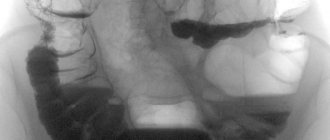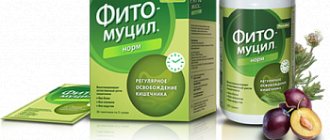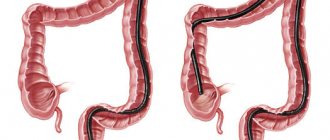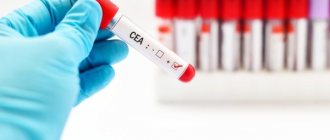Anoscopy - what is this procedure? Anoscopy is a non-invasive instrumental research method. Proctologists at the Yusupov Hospital use it to objectively assess the condition of the anal canal.
Anoscopy is not performed without preparation. Medical personnel conduct special training, which is prescribed by the doctor. Patients often ask the doctor: “Anoscopy – does it hurt?” Reviews about the procedure indicate that during the study the patient may experience minor discomfort.
Rectoscopy is an effective diagnosis of the rectum
Modern proctology uses examination of the rectum using a proctoscope for diagnosis, treatment, and prevention of a number of pathological conditions of this organ.
The rectum is the final part of the human digestive tract, into which food remains that are not absorbed into the small intestine, along with water, pass. Its function is to ferment them and form feces. The rectum ends with the anus, through which they are excreted. In addition, the procedure allows you to examine part of the sigmoid colon, namely its distal sections, which pass into the rectum.
The rectoscope, which is used during the procedure, is equipped not only with lighting, but also with an air supply system. Thanks to it, the endoscopist can inflate the intestinal cavity and get an overview of the diagnosed areas and parts of the organ.
The procedure is effective for identifying neoplasms of a benign or malignant nature at different stages of their development. It allows you to obtain data on the state of the anatomical structure down to a level of 25 cm from the anus. Sigmoidoscopy with biopsy makes it possible to obtain tissue samples for histological studies and clarify the diagnosis. It has minimal contraindications and, when performed correctly, is characterized by minimal discomfort, which allows you to avoid the use of anesthesia.
Sigmoidoscopy (rectoscopy)
Sigmoidoscopy (rectoscopy) is a method of endoscopic examination of the rectum and distal sigmoid colon by examining their internal surface using a sigmoidoscope inserted through the anus.
Sigmoidoscopy is the most accurate and reliable examination of the rectum and lower sigmoid colon. In the practice of a coloproctologist, sigmoidoscopy is a mandatory component of every proctological examination. This study allows you to visually assess the internal surface of the rectum and distal third of the sigmoid colon to a level of 20-35 cm from the anus.
Rectoscopy, carried out for preventive purposes, is becoming increasingly widespread. As a preventive measure for the early diagnosis of malignant neoplasms of the rectum, people over 40 years of age are recommended to undergo sigmoidoscopy once a year.
With skillful use of a rectoscope, this procedure is painless or slightly painful and does not require preliminary anesthesia.
Contraindications
There are practically no contraindications to examining the intestine through a sigmoidoscope. However, in some conditions and diseases (profuse bleeding from the intestine, narrowing of its lumen of a congenital or acquired nature, acute inflammatory diseases of the anal canal and abdominal cavity, acute anal fissure), the study is postponed for some time (for example, during a course of conservative therapy) or performed with great care with the patient in gentle positions or after anesthesia.
Sigmoidoscopy technique
To complete the test, you will need to lie on your left side in a comfortable position.
Sigmoidoscopy is performed only after direct digital examination of the rectum. Sigmoidoscopy with rigid tubes is usually performed in the knee-elbow position of the patient. This position is very convenient for examination: the anterior abdominal wall seems to sag a little, which makes it easier to pass the tube from the rectum to the sigmoid colon.
The assembled sigmoidoscope, after checking the operation of the lighting system and lubricating the tube with Vaseline or a special gel, is inserted into the anus along the longitudinal axis of the anal canal to a depth of no more than 4-5 cm. Then the obturator is removed, and all further sigmoidoscopy is performed only under visual control. The tube is passed so that its edge does not rest against the intestinal wall, but follows strictly along the intestinal lumen, while air is constantly pumped into the intestine.
When performing sigmoidoscopy, attention is paid to the color, shine, moisture, elasticity and relief of the mucous membrane, the nature of its folding, features of the vascular pattern, the presence of pathological changes, as well as to evaluate the tone and motor function of the examined sections. In a healthy subject, during sigmoidoscopy, the mucous membrane has an intense pink color, a shiny, smooth and moist surface with a good light reflex; it is elastic, the vascular pattern is delicate or absent. The mucous membrane of the distal part of the sigmoid colon is pink with smooth circular transverse folds; the thickness and height of the folds do not exceed 0.2 cm. The vascular pattern has a delicate network and is more clearly visible. The tone of the intestinal wall is determined when the tube is removed. Normal intestinal tone is characterized by a cone-shaped uniform narrowing of the lumen with a preserved relief of the folds.
Complications
Sigmoidoscopy is a safe procedure.
Complications (perforation of the intestinal wall, etc.) with methodically correctly performed rectoscopy are extremely rare. In case of perforation of the rectum, emergency surgery is indicated.
Preparation for sigmoidoscopy
An important condition for performing sigmoidoscopy is thorough cleansing of the colon from contents. On the eve of rectoscopy, the patient is prescribed a low-slag diet during the day, and only tea in the evening. The study is carried out on an empty stomach.
To prepare the intestine for examination, it is cleaned using enemas (1.5-2 liters of plain water at body temperature). It is advisable to do the first enema the evening before the examination; approximately 3-4 hours before the examination, 2 more enemas are given with a 45-minute break.
An Esmarch mug is used to perform a cleansing enema. It can be bought at almost any pharmacy
An Esmarch mug is a reservoir (glass, enamel or rubber) with a capacity of 1.5-2 liters. At the bottom of the mug there is a nipple onto which a thick-walled rubber tube is placed. For a rubber reservoir, the tube is its direct continuation. The length of the tube is about 1.5 m, the diameter is 1 cm. The tube ends with a removable tip (glass, plastic) 8-10 cm long. The tip must be intact, with smooth edges. It is preferable to use plastic tips, since a glass tip with a chipped edge can seriously injure the intestine. After use, the tip is washed well with soap under running warm water and boiled. Next to the tip on the tube there is a tap that regulates the flow of fluid into the intestines. If there is no tap, it can be replaced with a clothespin, clamp, etc.
For enemas, use only water from a proven source (one that is safe to drink). For children, it is better to use only boiled water. The water temperature is about 37-38 degrees. Colder water significantly increases intestinal motility and causes unpleasant pain. Using water with a temperature of more than 40 degrees for an enema is dangerous to health. One way to perform an enema is as follows. Lie on the bed close to the edge on your left side with your legs bent and pulled towards your stomach. Place an oilcloth (plastic film) under your buttocks, and lower the free edge of it into a bucket in case you cannot hold water. Pour 1-1.5 liters of water at room temperature into Esmarch's mug, lift it up to a height of 1-1.5 m and lower the tip down to release a small amount of water and along with it air from the tube. Fill the tube (drain some liquid from the tube), then, without lowering the mug, close the valve on the rubber tube. Check if the tip is broken, lubricate it with Vaseline (soap, vegetable oil) and, spreading the buttocks, insert the tip into the anus with light rotational movements. The first 3-4 cm, insert the tip towards the navel, then another 5-8 cm - parallel to the tailbone. If there are obstacles and the tube rests against the intestinal wall or hard feces, remove it 1-2 cm and open the tap. Pressurized water will enter the large intestine. Almost immediately there will be a feeling of “fullness” in the intestines and an urge to stool. At these moments, you need to reduce the flow rate of liquid from the mug by closing the tap on the tube or squeezing it. Gentle circular stroking of the abdomen will help reduce discomfort.
If the tip is clogged with feces, it should be removed, cleaned and reinserted. If your rectum is filled with stool, try flushing it out with a stream of water. Esmarch's mug does not need to be completely emptied. Leaving a little water at the bottom to prevent air from entering the intestines, close the valve that regulates the flow of liquid and remove the tip.
Place a pre-prepared pad (cloth, repeatedly folded toilet paper, etc.) on the perineum, which must be pressed between the legs.
Indications and contraindications for rectoscopy
Specialists from different fields can refer you for rectoscopy: proctology, oncology, surgery, gastroenterology. It can be carried out as part of a routine inspection, as well as on an emergency basis.
| Indications | Contraindications |
Routine diagnostics are carried out if the patient complains of:
The procedure is carried out urgently in case of intense bleeding for health reasons. Other indications are as follows:
| The procedure is not performed in cases where the risk from its use is higher than the need. The decision is made by a specialist based on the patient’s individual testimony. Contraindications are:
|
How is sigmoidoscopy different from colonoscopy?
Many patients have heard about another method of diagnosing the intestines from the inside - colonoscopy - and want to know how it differs from sigmoidoscopy of the rectum. Although both procedures are equally valuable as diagnostic tests and can be performed alongside biopsies and medical procedures, they have a number of differences, which are presented in our table below:
| Options | Sigmoidoscopy | Colonoscopy |
| Field of study | Rectum and part of the sigmoid | All parts of the large intestine |
| Invasiveness | Small | High |
| Painful sensations | Minimal or absent. | Palpable and require anesthesia. |
Sigmoidoscopy - reviews
Positive feedback
Until the age of 24, I lived with rose-colored glasses, until I ended up in the maternity hospital. And no, my birth was, let’s say, successful, except that I had a cesarean section, and after that everything was within normal limits, but I returned home a different person. Let's rule out that I became a different person because I became a mother, the matter is different. In the maternity hospital, I learned about all sorts of illnesses that I didn’t even suspect about. At that time, it’s true that I didn’t have them, but life did not become the same. Every little thing now makes me panic, I feel like some kind of granny.
For example, I then found out about hemorrhoids, because before that I had no idea what it was, how it manifested itself and how much it interferes with life, I didn’t know what an enema was, I was afraid of it, probably even more than the birth itself, I didn’t know about all the episiotomies and all the other horrors.
Okay, let's go back to the present day. The worst thing that I was afraid of after the maternity hospital happened to me the most. I developed an anal fissure and had to see a proctologist. It would have been more difficult for me to decide on this if it had not been for the maternity hospital, where probably everything shameful that could have happened happened.
And then my tailbone hurt. It hurt very badly and for a long time, so much that I could not sit at all, and I could not lie flat, only on my side and stomach. The neurologist prescribed endless anti-inflammatory drugs, which did not help at all, not even an ounce, not for a minute, not for a second. And so it went on for three long, painful months, during which I had already given up and decided that I would remain with this sore until the end of my days, which would soon come, from such and such unbearable pain.
Having once again read on the Internet “what makes the tailbone hurt,” I found information that it can hurt from problems in the rectum. I decided to go to a proctologist to consult, to which he confirmed that, in principle, it could hurt and I needed to look at my intestines. At that time, I was even ready for a colonoscopy, but the proctologist said that it would be enough to do a sigmoidoscopy, it looked 22 cm in the intestine, and there was no need for further, it wouldn’t give into the tailbone. Here it must be said that the proctologist immediately said that there was a possibility that the problem was in the intestines, but it was very small, more suitable for neurology, but he said to prepare for a sigmoidoscopy to look just in case.
I prescribed several medications for preparation; I chose Lavacol, since it was the most affordable. You can read about the preparation procedure
here in this review. Before the procedure, you must follow a diet, do not eat berries with skins, for example, because the skins linger on the intestinal walls, which can make examination difficult.
What to take with you:
On the appointed day, I came to the clinic on an empty stomach for the procedure. Since I paid a fee, I didn’t take anything with me, everything was provided there. If you are visiting a government institution, you need to take a sheet with you on which you will lie on your side or stand on your knees and elbows. They may ask you to put shoe covers on your socks or just take fresh socks with you, but this depends on the doctor. Mine told me to just take off my shoes, it was summer, I was wearing sandals, that is, I took them off and was barefoot. You can also take a napkin with you to wipe yourself after the procedure if necessary.
The procedure itself:
I was told to get into a knee-elbow position. By the way, even though the clinic was paid, they didn’t give me disposable panties with a hole in the butt, although at that time I didn’t really care about them. Afterwards, the proctologist looked at the intestine with his finger. He poked his tailbone through the intestine. He asked if it hurt or not, I said it didn’t hurt at all. An examination with a finger is not scary, it is not painful or uncomfortable at all (psychologically uncomfortable), if everything is in order there. If there are hemorrhoids or a fissure, then, of course, it will hurt.
Afterwards, the doctor took a disposable device; I was too lazy to Google what it was called. I saw it packed, it looks like a small transparent tube, but I couldn’t see it at the ends. I didn’t see where it connects (you’ll see, in such and such a position). The doctor warned that he was introducing a device, but I didn’t feel anything special. The first time it became unpleasant was when the tube touched the first twist. I don’t even know what to compare it with. But in general, it looks like the tube is rubbing against the body, but not from above, but inside you. That is, there is no pain, just friction. Then, while the device passes through a “flat” section of the intestine, nothing is felt at all. But these sections pass quickly, in 5-7 seconds, it seems to me, and then there’s another twist, and again it’s as if the tube is resting on you, but inside. Sometimes it was a little painful, but not so much that there is no patience, it can be compared to a second of pain from menstruation (if a man is reading the review, then you can also compare the pain to a pinching, but inside the body) As soon as the turn is passed, everything is fine again.
The doctor pumped a little air into the intestines, but only a little, so that he later said it himself, I did not notice that the intestines were inflated and swelled, as with an enema.
As soon as the tube runs out, and it, as I said, allows you to look at 22 cm, the doctor pulls it out, and it is not clear whether it is pulled out or the procedure continues. It becomes clear that the tube was pulled out when it passed through the anus. And then the doctor says that you can get off.
After I got off and bent over to put on my sandals, I felt a pain on my side in the area of my intestines. It’s as if I’m being squeezed inside with all my might and I can’t relax. When I inhaled, it was as if there was not enough room for this fist and there was a terrible sharp pain. The doctor put me on the couch and told me to lie down because my muscles were tight from tension. I lay there for about two minutes, and although the doctor said to lie still, I got up and nothing hurt anymore. But then, throughout the day, when I bent, I felt discomfort.
As a result, they didn’t find anything for me.
By price:
For a disposable tool 1400 rubles. For a reusable device, about 1200, if I'm not mistaken.
CONCLUSION
The devil is not as scary as he is painted.
Preparation for sigmoidoscopy
In order for the procedure to be as effective as possible and cause minimal discomfort, the patient needs to properly prepare for it. Specialists from Doctor Nearby clinics talk in detail about exactly what measures need to be taken.
They are aimed at eliminating feces, which are a serious obstacle to the procedure. You need to start implementing them no later than two days before the diagnosis. The patient needs to stop consuming products made from coarse dietary fiber, as well as products that promote gas formation.
During this period, it is allowed to consume liquid food. As for the cleansing itself, the doctor decides how best to carry it out: he can prescribe a cleansing enema the day before and on the day, or take laxatives.
Preparation for anoscopy
In order for the doctor to qualitatively examine the rectum during anoscopy, preparation for the examination is carried out. Doctors recommend that the patient give up fatty foods and avoid eating foods that provoke the formation of gases in the intestines. On the day of the examination, the nurse gives a cleansing enema with a volume of 1.5-2 liters. Sometimes doctors prescribe laxatives. The patient takes them orally in the evening, on the eve of the study. If the patient has a low pain sensitivity threshold, he is given an intramuscular injection of an analgesic drug. Local anesthesia is used in case of increased pain sensitivity of the anus and rectal mucosa.
An Esmarch mug is used to perform an enema. At home, the patient can use an ordinary rubber heating pad with a tube and tip. The patient fills the heating pad with warm tap or boiled water. From the set of tips, you should choose one that is approximately equal to the size of your index finger, and lubricate it with any greasy base (oil, Vaseline). Next, you should lie on your left side, bending your legs at the hip joints and knees at a right angle (take the so-called fetal position). It is most comfortable to lie on the floor in the room, with a large towel under you. A heating pad with water should be placed at a height of 1–1.5 meters above the floor. The tap on it must be closed. If there is no tap, you can simply bend the tube and ask an assistant to hold it.
Next, with your hand (as you feel), you need to insert the lubricated tip into the anus and hold it until the end of the water injection. You can have an assistant insert the tip or do it yourself. After inserting the tip, the assistant releases the bent tube or opens the tap. If the water does not come out, you can squeeze the heating pad a little. Sometimes it happens that the tip rests on the feces and the water does not flow. All the water goes into the rectum in 5–10 minutes. In this case, minor pain is possible, which is associated with the straightening of the intestine with water. After filling the intestines with water, you need to wait a few minutes and empty the intestines into the toilet. After an hour, the procedure is repeated
You can prepare for anoscopy with the help of the drug Endofalk. Some patients tolerate such preparation for anoscopy more easily than an enema; other patients have an unpleasant taste of the medicine. The package contains 6 packets of the drug Endofalk. If the patient weighs 80 kg, it is enough to purchase 2 packets of the drug at the pharmacy; if the patient weighs more than eighty kilograms, 3 packets of the medicine are needed. After dissolving the powder in water, the patient drinks the solution. The drug is not absorbed in the intestines, but washes it and comes out.
Two packets of endofalk are dissolved in one liter of water or clarified juice, 3 packets - in one and a half liters. If the proctologist has prescribed an anoscopy in the first half of the day, you need to start preparing from seventeen o’clock in the evening preceding the day of the examination. The patient needs to drink 1 glass (250 ml) of solution every 15 minutes (1 liter per hour). After consuming the entire solution, the urge to defecate appears, and rinsing water begins to come out. After finishing taking Endofalk, the patient goes to the toilet for another 1–2 hours.
How is sigmoidoscopy of the sigmoid and rectum performed?
The procedure is carried out in an outpatient setting in a specially equipped room. It does not require anesthesia as it is virtually painless. It is extremely rare that if the patient has pathologies of the anus, local anesthesia may be performed.
Before starting the examination, the diagnostician conducts a digital examination of the rectum.
The patient is asked to lie on his left side and pull his knees to his chest. There is another possible position in which the study is carried out: knee-elbow. Before inserting the rectoscope tube into the rectum, the diagnostician generously lubricates the patient’s anus with Vaseline. The tube is inserted to a depth of about five centimeters, after which air is pumped in order to straighten the folds of the intestinal mucosa.
The above processes are carried out under the visual control of a diagnostician, and the areas under study are photographed. The procedure may cause discomfort, which is considered normal. The diagnostician may ask the patient to rise from time to time if this is necessary to easily advance the proctoscope.
The rectum becomes the sigmoid colon at a height of 12 to 14 mm. During the process of passing this area with a proctoscope, the patient should be as relaxed as possible in order to exclude such a complication as perforation of the intestinal wall. If the patient experiences pain, the procedure is stopped.
A good overview of the areas under study is provided by special optics. On average, the study lasts about twenty minutes. In accordance with the indications, a biopsy or manipulation is performed to remove polyps or administer medications.
What is anoscopy and how is it performed?
Visual examination of the rectal mucosa (anoscopy) is carried out using an endoscopic anoscope device. This is a tube no more than ten centimeters long, which is equipped with a light guide. The diameter of the smooth metal rod does not exceed one centimeter. The proctologist can conduct an examination in one of the following positions of the patient:
- Lying on your back on a gynecological chair;
- Lying on your left side with your knees bent and legs pressed to your chest;
- Standing on your knees, leaning on your elbows.
The proctologist inserts the instrument into the rectum with careful circular movements. The doctor conducts a visual examination of the mucous membrane of the rectum for ten centimeters from the anus. The total duration of the examination varies from 10 to 15 minutes. During the examination, the proctologist takes a smear from the mucous membrane of the rectum. If indicated, he performs a biopsy - taking a piece of tissue for subsequent histological examination. At the end of the procedure, the doctor carefully removes the anoscope.
Interpretation Sigmoidoscopy
In the process of deciphering the received data, the specialist compares them with the results of the norm, which allows you to make a diagnosis or decide on the tactics of further diagnostic studies.
If inflammatory processes, neoplasms or erosions have been identified during the process, the diagnostician indicates their location, determines the nature and extent of the pathological process. The patient receives diagnostic results on the same day and can immediately consult with the attending physician.
Advantages of sigmoidoscopy at Doctor Nearby clinics
Specialists from Doctor Nearby clinics will help eliminate the risk of complications and discomfort during the procedure. They have modern rectoscopes and effective painkillers, which can be used if the patient has indications.
They have carried out this procedure several times, so they are well familiar with all its features and nuances. If you want to be sure that sigmoidoscopy will be performed correctly and safely, contact us!
You can find out the cost of the procedure in the price list in this section of our official website!






